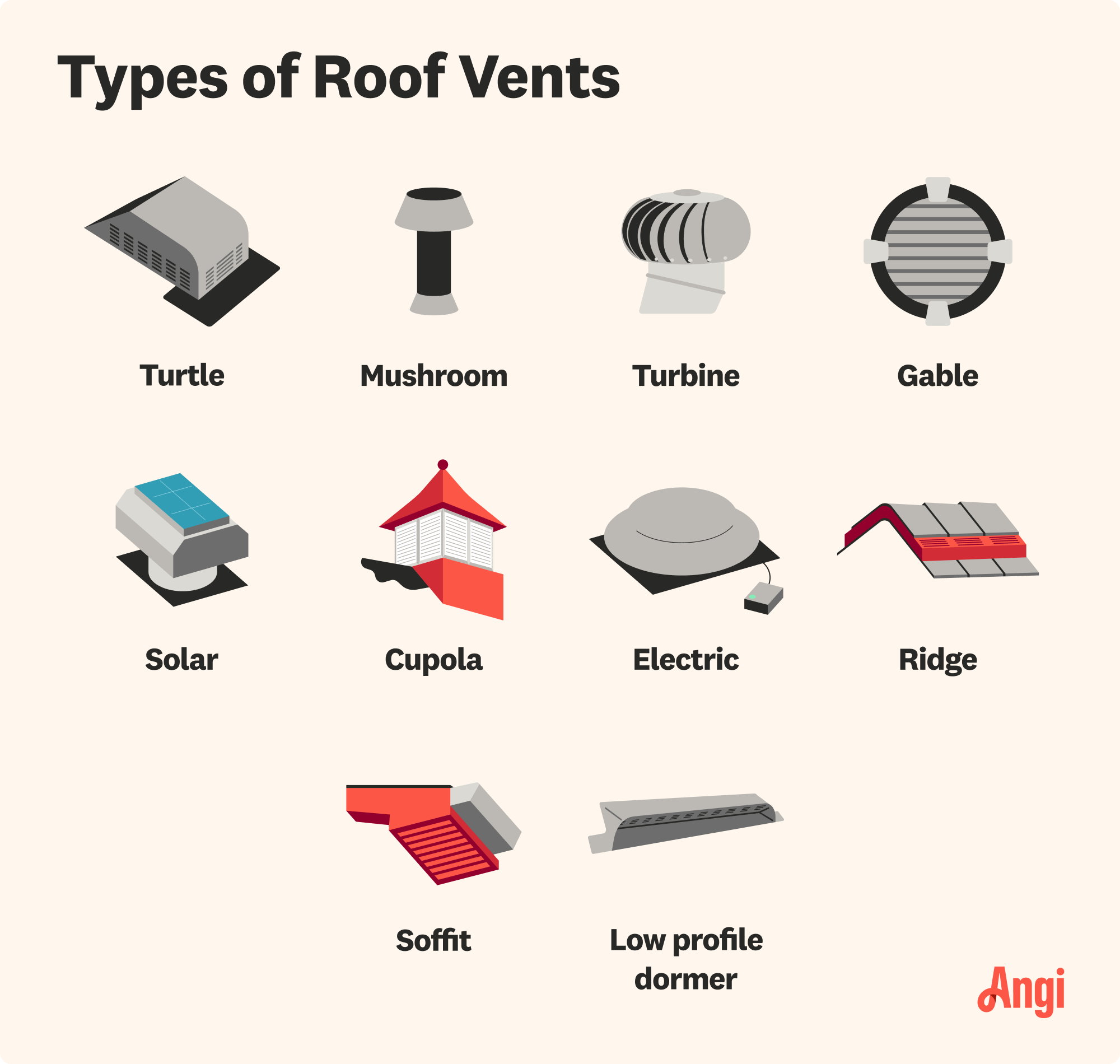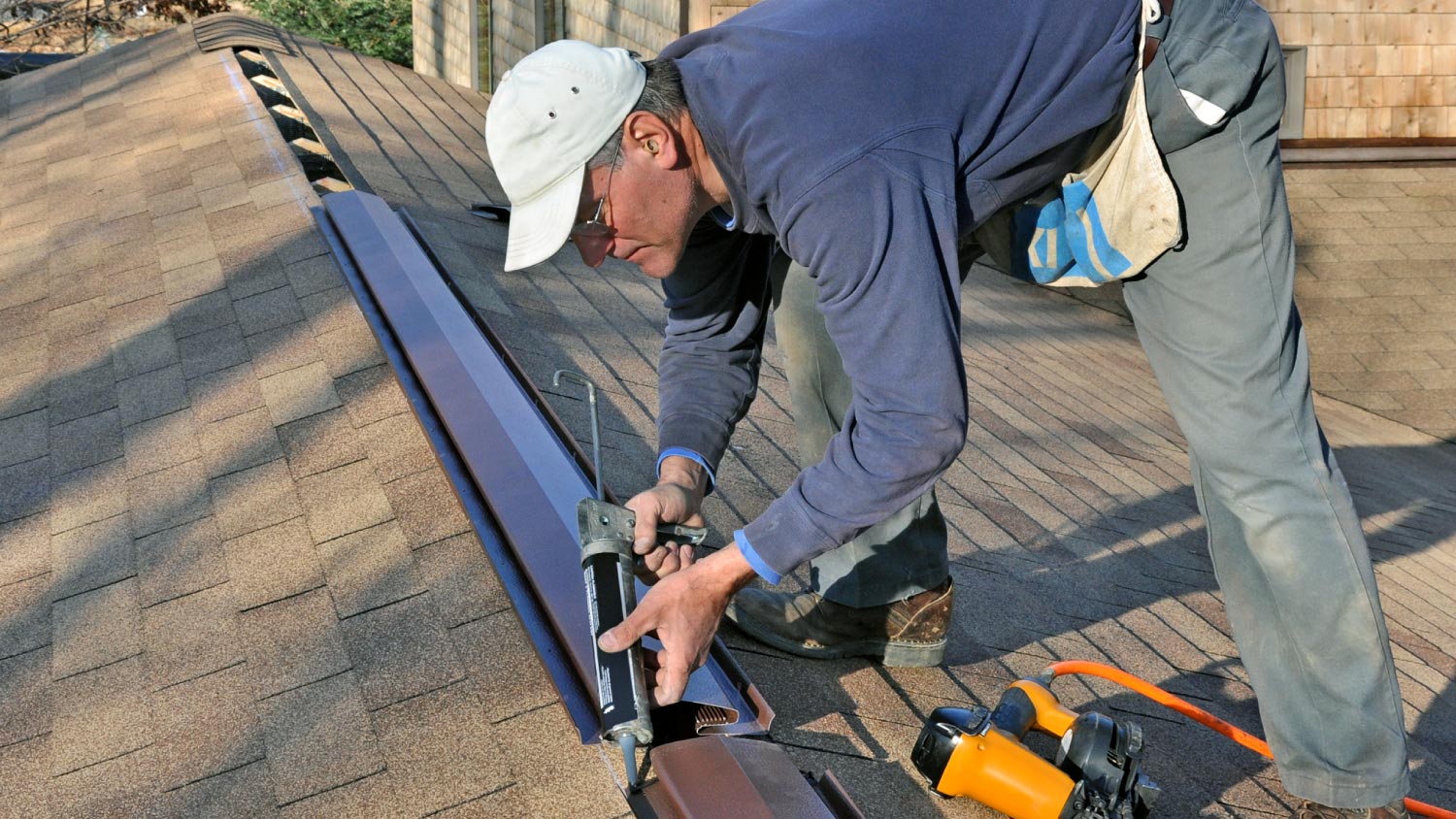
Looking to boost your home’s curb appeal and protect it from water and rodents? Learn about the cost to install aluminum soffits and what affects pricing.
Improve the airflow in your attic without sacrificing curb appeal


Roof ridge vents are installed along the peak of the roof.
They improve airflow and extend a roof’s lifespan.
Ridge vents with baffles offer better protection against wind, rain, snow, and insects.
Ridge vents cost between $300 and $650 to install, on average.
When you’re searching for the best roof vent for your home to keep the air flowing in and the moisture out, you’ll likely come across ridge vents. In this guide, learn the benefits of ridge vents plus their cons and estimated costs.
Ridge vents are installed along the ridge, or peak, of the roof. Placed at the highest point of the roof, these vents help to control airflow in the attic by drawing warm air and moisture out, allowing air circulation.
Ridge vents are installed over an air slot that is cut directly into the roof deck and typically runs the entire length of the ridge. Once installed, it is covered with the roofing material which helps it blend into the roof.
Like your kitchen or bathroom, your roof needs ventilation to extend its life span and control temperatures. Proper roof ventilation helps reduce HVAC costs and prevents ice dams and moisture damage. A roof repair pro can assess your roof and make recommendations.
There are two types of ridge vents: ones with a baffle and ones without a baffle, and the one you choose will depend on your particular roof and its needs. Most ridge vents in areas that get regular rain or snow use baffles.
A ridge vent with a baffle uses an external baffle to deflect rain, wind, snow, insects, and debris, keeping it from entering the vent and, ultimately, the attic.
Ridge vents without baffles reduce the suction that roof vents with baffles create. Air is allowed to flow into the ridge vent, which prevents warm air from escaping or only allows it to escape from one side of the vent.
| Pros | Cons |
|---|---|
| Better attic airflow | Potential leakage |
| Good aesthetics | Tricky DIY install |
| Increased roof life | Won’t fit some roofs |
| Blocks insects | Snow penetration |
| Dissipates humidity | Costlier upfront |
If you have heat or humidity buildup in your attic, the biggest benefit of roof ridge vents is their ability to improve airflow in this space. If left unchecked, heat and humidity could cause mold and mildew in your attic, as well as an unpleasant, musty smell. As mold and mildew build up, your roof may suffer unnecessary rot damage, necessitating replacement.
The design of the roof ridge vents won’t detract from the look of your home or roof. They have a low profile that’s not obvious at a glance, unlike some other designs. Additionally, insects cannot penetrate these seamless-style vents.
However, the roof ridge vent design could allow snow or rain to penetrate, especially when high winds are driving the precipitation. Following the proper installation technique is key to reducing issues with this type of moisture penetration. Certain roof design styles, such as hip roofs, do not work well with roof ridge vents. Gable roof designs tend to accommodate this kind of vent well, though.
What is a ridge vent and how does it compare to other venting options? Here is how these vents compare.
Soffit vent versus ridge vent: The soffit vent sits under the eaves of your home, while the ridge vent sits at the peak of the roof. Homeowners often use these two passive vents together for maximum airflow.
Gable vent versus ridge vent: The rectangular gable vent sits at the peak of the gable roof. It’s easier to install than the ridge vent, but the ridge vent is less likely to leak while providing greater airflow. Both types are passive vents.
Box vent versus ridge vent: Box vents can go anywhere along the slope of the roof. They are clearly visible, causing reduced curb appeal, unlike ridge vents. Ridge vents can move more air and have less of a chance of leaks than box vents. Both are passive vents.
Roof turbine versus ridge vent: Roof turbines use circular blades to catch wind. The turbine then spins and moves air inside the attic. Even though they don’t use electrical power, the moving parts mean roof turbines are not passive like ridge vents. Roof turbines cost less, but they tend to require more frequent maintenance than ridge vents. Some homeowners also consider them eyesores.

Unlike other styles of vents, where you count the number of vents you need, it’s easier to count ridge vents by the linear feet they occupy.
Each linear foot of a ridge vent provides about 18 square inches of passive venting capability. For passive vents, you should need 200 to 250 square inches of passive venting per 1,000 square feet of attic space.
Based on those numbers, here is approximately how many linear feet of roof ridge vents you need. If you have odd angles in the attic that significantly affect airflow, you’ll need more linear feet of ridge vents.
| Feet of Ridge Vents | Attic Space (Sq. Ft.) |
|---|---|
| 6–7 | 500 |
| 9–10 | 750 |
| 12–14 | 1,000 |
| 18–20 | 1,500 |
| 24–26 | 2,000 |

The average cost to install ridge vents is $300 to $650, including $2 to $3 per linear foot for the material and $45 to $75 per hour in labor fees. Here’s a look at how much it costs to have a pro who installs roof vents put in other kinds of vents:
Soffit vents: $315–$465
Gable vents: $60–$150
Roof turbine: $65–$250
However, most roofing contractors won’t charge extra to install ridge vents if you are replacing the entire roof. When choosing a roofer, find out if installing ridge vents will cost extra. If you need assistance with seeing whether the benefits of ridge vents are right for you, contact your local roofing contractor.
Roof ridge vent installation is best done when the entire roof is being replaced, but they can be added at any time. Here are some signs that your roof may need more ventilation:
Water damage or mold in the attic: High heat and humidity levels in the attic occur because of poor ventilation and airflow, leading to damage from excess moisture.
Ice dams in the winter: Without proper ventilation in the attic, you may have inconsistent temperatures on the surface of the roof. Melting snow from warmer areas can’t drain away because ice remains in place in colder areas and blocks the water flow. Ice dams eventually cause roof leaks.
Cracked or loose shingles: When temperatures are too hot in the attic, the excess heat can affect the integrity of the shingles overhead, causing them to break down or crack prematurely.
Extreme heat in the attic: If you feel a blast of hot air each time you enter your attic, this is a sign of poor ventilation, which can lead to a buildup of humidity and the formation of mold.
Unusually high energy bills: Proper ventilation in the attic improves the ability of your heating and cooling system to maintain consistent temperatures throughout the home, leading to lower energy costs.
Leaks all over need a tarp over 30 in garage Sure 1002 more rest roof
This is an A+ company. If you are looking for anything to do with Roofing or gutters this is the company to go with!
I called Ken and within two weeks I had my roof replaced. Other people told me that they were on a waiting list with their roofing company, so I wasn't expecting to get such prompt service. My daughter got her roof replaced earlier in the summer by someone else and it was the about the same...
The roofing job went very well. There are some loose boards on the siding. Once the job started, everything was done very quickly.
I had gutters installed in spring of 2013. Have a problem area in the front and they have been out to fix and replace it a couple of times. Always promptly and always responsive to service calls. Had the roof replaced a couple of days ago, which we figure may have been a contributing...
This was a remodel project that started with the simple idea of adding three sky lights to the ceiling with a square tunnel from each light in the roof to the ceiling in the livingroom. It was evident when the first light & tunnel were installed that this was not the look we wanted. We...
They gave me a good estimate and they were very responsive. They gave me the best assessment of my roof, but there price was higher.
they replaced individual shingles that were damaged by hail. house approx 8 yrsold, roof in good condition. they did not try to sell whole new roof. good people.
Academy Roofing were very nice people. They were very helpful.
The estimator came the same day I called as I had discovered a leak from the previous evening downpour. He was very courteous and knowledgeable. The written estimate for repair versus whole roof arrived within the week.
From average costs to expert advice, get all the answers you need to get your job done.

Looking to boost your home’s curb appeal and protect it from water and rodents? Learn about the cost to install aluminum soffits and what affects pricing.

Synthetic cedar shake roofing is a sustainable alternative to the popular wood. Learn what influences synthetic cedar shake roofing costs for your home.

Copper is a luxury roofing material that’s highly desirable and maximizes curb appeal. Learn about copper roof costs and price factors in this guide.

Courteous homeowners may wonder what the etiquette is when it comes to tipping roofers. Find out if, when, and how you should tip roofers for a job well done.

Discover the cost to paint a metal roof, including average prices, key cost factors, and tips to help you budget and save on your next roofing project.

It's hard to walk down the street without spotting a gable roof. Here are the main pros and cons of gable roofs and how they stand up against the elements.